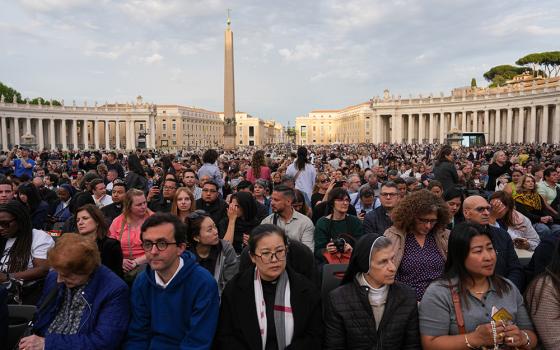
WEST PALM BEACH, Fla. -- As Armando Gil departed Havana in 1965, his father's last words to him, whispered in his ear, were: "Under no circumstances are you to return as long as there is communism in Cuba."
Bound for Mexico, then the United States, Gil was not in the United States a full year before he was off to boot camp for the U.S. Navy. Today, he is a retired schoolteacher, self-described "cradle Catholic" active in the Cursillo Movement and proud grandfather in Jacksonville.
In all these years -- even as U.S. travel restrictions to Cuba have periodically eased -- he has never been back to his birthplace in Hershey, Cuba, where a defunct chocolate factory was once associated with the American food company of the same name.
"I have not been able to see where my father is buried although I know where he is at," said Gil, 69.
For Gil, so long as there is communism on the island, he will stay away. He is, nevertheless, understanding of the papal visits to Cuba and tolerant of younger Cuban-Americans who are traveling to Cuba to visit relatives.
"The pope, as vicar of Peter, has to go; after all, they criticized Christ for sitting with the tax collector," he said of Pope Benedict XVI's three-day papal visit to Santiago and Havana on March 26-28. Before he arrives in Cuba, the pope will visit Leon, Mexico, March 23-26.
"I have cousins who have gone back," Gil told Catholic News Service, adding that he thinks Americans should not travel to Cuba without remembering the ongoing human rights violations and harsh realities there.
"I think it is not a positive thing for the people in the States to be contributing their dollars to the dictatorship since things have not changed, but I will not jump on anybody for going," Gil said, who attends St. John the Baptist Parish in the Diocese of St. Augustine, now under the leadership of Cuban-born Bishop Felipe J. Estevez.
Gil's generation of Cuban-Americans left 30 and 40 or more years ago and moved out into mostly U.S. urban areas. Many lived first in Spain or in a variety of Latin American countries before immigrating to North America. For many years, his generation was a cohesive voice in condemning Fidel Castro and supporting the U.S. trade embargo against Cuba.
Over the years and aided by Spanish-language media, the Cuban diaspora followed developments with the Castro regime from afar as time sometimes seemed to stand still for a divided people still carrying the wounds of displacement.
"We are sort of like the Jewish people, scattered all over the world," Gil said.
The image of Our Lady of Charity of El Cobre is a unifying symbol for Cuban-Americans, and south Florida is home to a popular national shrine in her honor. Whether in New York, California or Florida -- states with high percentage of exiles -- Gil believes Cuban-Americans have adapted well to their new home. They are devoted to church, family, the value of higher education and hard work, he added.
With Blessed Pope John Paul II's historic 1998 visit to Cuba, the aging of the Cuban-American leadership in Florida, and the national trauma of the Elian Gonzalez child custody episode in Miami, some point to a softening of animosities toward Cuba, especially among the younger generation, who seem to have a more open attitude toward dialogue.
The government's modest economic reforms and a release of 2,500 prisoners in advance of the papal visit offer a few such indicators. Brisk business among U.S. charter air carriers taking Cuban-Americans to Cuba shows a quiet change on the American side.
"I try to go two times a year because my parents there are very old and I feel so good to spend time there," said Alina Wetzstein, a case manager at Camillus Health Concern, a Miami-based ministry to the homeless operated by the Brothers of the Good Shepherd.
Brought up in a typical Havana communist household, Wetzstein started visiting a local Catholic church there with her children in the early 1980s. She later fled to Venezuela when her husband's unauthorized shoe-making business risked bringing unwanted reprisal from the government.
Today, Wetzstein, 56, avoids political conversations and heated local politics regarding Cuba. She has close English-speaking friends, and belongs to a Miami parish not considered central to local Cuban-American life. In December, she went to Cuba for Christmas and plans to go again for the papal visit.
Wetzstein speaks of the new openness of religious expression in Cuba but also of the need for greater faith formation there.
"I think for the people in Cuba, it is very important to have contact with us and to see how we are and how we live," she said. "The Catholic church there and the pope coming to Cuba are important because they can help to heal, to bring together people who made mistakes, including mistakes made here, too."
In Philadelphia, Immaculate Heart of Mary parishioner Elvira Zuazo-Legido overcame objections from family four years ago when she and her husband attended a medical conference in Cuba. She saw the poverty, met with distant relatives, visited churches and talked with locals frustrated with their situations.
Cuban-Americans, according to Zuazu-Legido, share a common sense about life's priorities that comes out of their difficult history.
"Material possessions aren't really important," she said, adding that her parents often assist new immigrants and are active in a local Cuban-American Club.
"It is sad to see a lot of the Cubans are getting old. There should be new blood going into the club and it would be cool if children would go to play dominoes with the older people," she said. "But I am not sure there is the interest."

